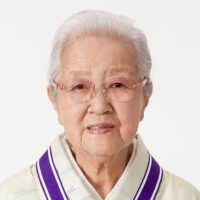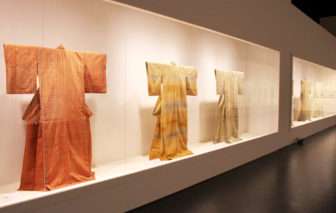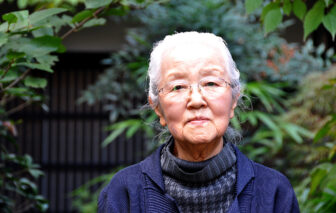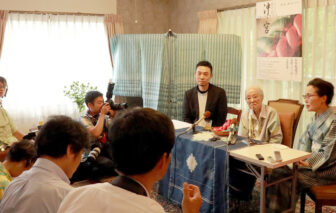
2014 Kyoto Prize Laureates
Arts(Painting, Sculpture, Craft, Architecture, Photography, Design, etc.)
/ Dyeing and Weaving Artist
1924 -
2014
11 /11 Tue
Place:Kyoto International Conference Center
Philosophy of Tsumugi: The World of Fukumi Shimura
2014
11 /12 Wed
14:00 - 17:30
Place:Kyoto Theater
Ms. Shimura has developed her original style of art, commanding an extraordinarily colorful range of plant-dyed yarns as her visual vocabulary and unleashing her imagination to improvise an infinite resonance of colors over canvases of tsumugi kimono. Through a constant communication with nature and deep meditation, she has cultivated a “tender and flexible thought that advances to weave human existence into nature.”
*This field then was Field of Arts (Painting, Sculpture, Craft, Architecture, Design).
Ms. Fukumi Shimura started her career as a dyeing and weaving artist after she became inspired by Muneyoshi (Soetsu) Yanagi’s Mingei Movement (the Japanese Folk Craft Movement). Since that time, she has made a profound study of the beauty of tsumugi (pongee) kimono, which Japanese peasant women traditionally wove for everyday use, and she has developed her own original style of art. Commanding an extraordinarily colorful range of mellow plant–dyed yarns as her rich visual vocabulary and giving free rein to her unique sensibility and creative imagination, she improvises an infinite resonance of colors over canvases of plain–weave fabric. Her work has not only broken stereotypes in Japanese tsumugi kimono, but also developed a radically new sense of beauty.
In various parts of the world, the process of making yarn, dyeing with plant-derived colors, weaving, wearing, and passing on memories has been performed without interruption from antiquity. Of all the varieties of fabrics, Ms. Shimura discovered infinite potential in the elegant simplicity of tsumugi.
Kusaki–zome, the Japanese technique of dyeing with various kinds of plants, is the act of “receiving colors” from nature. Ms. Shimura has striven to comprehend the mystery of nature, eventually coming into perfect synchrony with the complicated and delicate life phenomena of plants and perfecting the skills needed to make them manifest themselves in the form of exquisite colors. That, she implies, means to live in accordance with natural providence. Acknowledging the effect of celestial motions on the color of dyes, she works in harmony with the lunar phases, the cycle of the seasons, and the growth and decay of all living things.
“Plants do not yield green dyes. Why is it that the green hue that shows itself when the yarn is pulled up from an indigo jar disappears so quickly?” Asking herself this essential question, Ms. Shimura discovered a clue in the words of Johann Wolfgang von Goethe and Rudolf Steiner. Goethe says that Yellow appears next to the light; Blue appears next to the darkness; and Green appears when these two colors are mixed. Also, according to Steiner, “Green represents the dead image of life.” She encountered these thoughts while extensively exploring color theories around the world as well as the Japanese tradition of coloring, in her quest for this miraculous green plant color. This led her to a conviction that there is a “link with the invisible world” – and the discovery of the secrets of dyeing. The conviction and secrets have been reflected in her numerous works.
Ms. Shimura’s “philosophy of tsumugi,” formed through an intimate dialogue with nature, is a delicate and subtle concept which weaves human existence into nature. As such, it offers us suggestions as to the future course of humankind. Through the beauty of tsumugi backed by such deep contemplation, she pursues the fundamental human value of harmonious coexistence with nature.
For these reasons, the Inamori Foundation is pleased to present the 2014 Kyoto Prize in Arts and Philosophy to Ms. Fukumi Shimura.
Profile is at the time of the award.

Exhibition “Shimura Fukumi: Her Vocation to Weave Life” is Opening!
“Plants provide us with the splendid colours that they possess for nothing in return” —Fukumi Shimura, 2014 Kyoto Prize laureates in Arts and Philosophy The exhibition “Shimura Fukumi: Her Vocation to Weave Life” is running at Himeji City Museum of Art in Hyogo prefecture until August 30, 2020. This exhibition explores some 60 years of...

Japanese TV program “Okinomiya by Fukumi Shimura and Michiko Ishimure” The special exhibition at Kyoto
How does human being revere nature and live together? Dyeing and weaving artist Fukumi Shimura and author Michiko Ishimure are fused into new Noh play Okinomiya. Hand in hand, they appealed to the public a dignity of life beyond space and time. NHK production looked deeply into the background before realizing the eventual stage. Shimura’s...

Noh “Okinomiya” by Fukumi Shimura and Michiko Ishimure
The Press Conference of new product of Noh “Okinomiya” was held at the workshop: Tsukikobo in Sagano, Kyoto on June 29, 2018. Fukumi Shimura, Dyeing and Weaving Artist, disclosed her remembrance of a writer Michiko Ishimure who was her close friend over 30 years, and exhibited a Noh costume that she newly made as a...